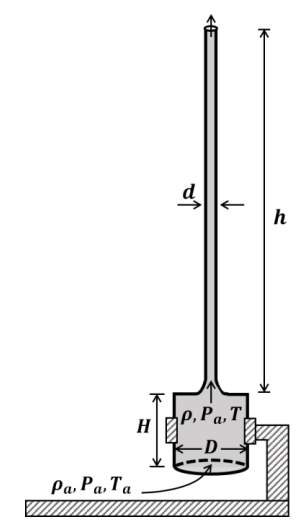Suppose the earth was covered by an oceam of uniform depth h,(h<<R) Let σ be densityof ocean and p be mean density of earth. Let Δg be the approxemate difference of value of net acceleration duet to gravity between the bottom of the ocean and top (Δg=g+(top)−gbottom). Choose the correct option.
Δg=43πGh[2p−3σ]
Δg=43Gπh[3σ−2p]
Δg=43Gπh[2σ−3σ]
Δg=43Gπh[3p−3σ]
gA=43GπRp
ge=G[43πpR3+[43π(R+h)3−43πR2]σ](R+h)2
=43GπpR[1−2hR]43Gπ[(R+h)−(1−2hR)R]σ
Δg=gB−9A=43πGh[3σ−2p]

Topper's Solved these Questions
Similar Questions
Choose the correct alternative
(a)Acceleration due to gravity increase/decrease with increasing altitude.
(b) Acceleration due to gravity increase/decrease with increasing depth (assume the earth to be a sphere of uniform density).
(c ) Acceleration due to gravity is independer of mass of the earth/mass of the body.
(d) The formula −GMm(1r2−1r1) is more/less accurate than the formula mg(r2−r1) for the difference of potential energy between two points r2 and r1 distance away from the centre of earth.
View SolutionAt a depth h1=R2 from the surface of the earth acceleration due to gravity is g1. It’s value changes by Δg1 when one moves down further by 1 km. At a height h2 above the urface of the earth acceleration due to gravity is g9. It’s value changes by Δg2when one moves up further by 1 km. If Δg1=Δg2 find h2. Assume the earth to be a uniform phere of radius R.
View Solution
Knowledge Check
Suppose the earth was covered by an ocean of uniform depth h,(h<<R) Let σ be density of ocean and p be mean density of earth. Let Δg be the approximate difference of value of net acceleration duet to gravity between the bottom of the ocean and top (Δg=g+(top)−gbottom). Choose the correct option.
AΔg=43πGh[2ρ−3σ]BΔg=43Gπh[3σ−2ρ]CΔg=43Gπh[2σ−3ρ]DΔg=43Gπh[3ρ−3σ]One end of a string of length L is tied to the ceiling of a lift acceleration upwards with an acceleration 2g. The other end of the string is free. The linear mass density of the string varies linearly from 0→λ from bottom to top. Choose the correct option(s)
AThe velocity of the wave in the string will be 0.BThe acceleration (relative to string) of the wave on the string will be 3g/4 every where.CThe time taken by a pulse to reach from bottom to will be √8L/3g.DThe time taken by a pulse to reach from bottom to top will be √4L/3g.Let gh and gd the acceleration due to gravity at height h above the earth s surface and at depth d below the earth surface respecitively if gh=gd then the releation between h and d is
Ad=hBd=h2Cd=h4Dd=2h
A cylindrical furnace has height (H) and diameter (D) both 1 m. It is maintained at temperature 360 K. The air gets heated inside the furnace at constant pressure P_α, and its temperature becomes T = 360K The hot air with density ρ rises up a vertical chimney of diameter d = 0.1 m and height h = 9 m above the furnace and exits the chimney (see the figure). As a result, atmospheric air of density ρα=1.2kgm−3, pressure Pα, and temperature Tα = 300K enters the furnace. Assume air as an ideal gas, neglect the variations in ρ and T inside the chimney and the furnace. Also ignore the viscous effects.
[Given: The acceleration due to gravity g = 10ms−2 and π = 3.14 ]
When the chimney is closed using a cap at the top, a pressure difference ΔP develops between the top and the bottom surfaces of the cap. If the changes in the temperature and density of the hot air, due to the stoppage of air flow, are negligible then the value of ΔP is _________Nm^(-2)
View SolutionAn engineer is designing a spring to be placed at the bottom of an elevator shaft, if the elevator cable should break at a height h above the top of the spring, calculate the required value of the spring constant k, so that passsengers undergo an acceleration of no more than 10 g when brought to rest, Let M be the total mass of the elevator and passengers
View SolutionWhen liquid medicine ρ is to be put in the eye, it is done with the help of a dropper. As the bulb on the top of the dropper is pressed, a drop froms at the opening of the dropper. We wish to estimate the size of the drop. We first assume that the drop formed at the opening is osperical becaus ethat requires a minimum increase in its surface energy. To datermine the size., we calculate the net vertical force due to the surface tension T when the radius of the drop is R. When this force become smaller than the wight of the drop, the drop gets detached from the droppr.
A glass capillary tube is of the shape of a truncated cone with an apex angle α so that its two ends have cross sections of different raddi. When dipped in water verically, water rises in it to a height h, where the radius of its cross section is b. If the surface tension of water is S, its density is ρ, and its contact angle with glass is θ, the value of h will be (g is the acceleration due to gravity)

View Solution

